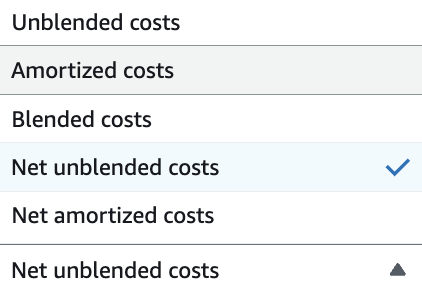Going to AWS explorer there are words you probably have never heard before. If you are a DevOps and not an accountant, it makes sense that you don’t know what it means. Understanding this AWS vocabulary is crucial to understand and optimize your AWS cloud spend. This article dives deep into five key cost perspectives: blended costs, unblended costs, amortized costs, net unblended costs, and net amortized costs.
1. Unblended Costs: A Straightforward View of Your Consumption
Unblended costs represent the most basic and transparent cost metric in AWS. Imagine it as a pay-as-you-go system, similar to how you pay for utilities. Unblended costs reflect the on-demand usage charges incurred for AWS services at the exact time you use them. Here’s a breakdown:
- Characteristic: Real-time reflection of usage
- Detail: Detailed breakdown by service, resource type, and usage duration
- Ideal for: Analyzing short-term usage patterns and identifying resource-specific cost drivers
- Example: You utilize an Amazon EC2 t2.micro instance for 10 hours. Your unblended cost will reflect the on-demand hourly rate for that instance type multiplied by the usage duration (10 hours).
2. Amortized Costs: Spreading Upfront Costs for Predictability
Amortized costs offer a different perspective on costs associated with Reserved Instances (RIs) and Savings Plans. These are upfront commitments you make to AWS in exchange for discounted pricing on specific services or instance types. Amortized costs represent the even distribution of these upfront commitments over the commitment period (e.g., one year or three years).
Here’s what you need to know about amortized costs:
- Characteristic: Spreading upfront commitment
- Accrual vs. cash basis: Amortized costs utilize an accrual accounting method, reflecting the cost as an expense over time regardless of when the actual payment is made. This contrasts with unblended costs, which follow a cashflow basis approach.
- Enhanced cost visibility: Amortized costs offer a clearer view of the effective cost of RIs or Savings Plans compared to simply viewing the upfront commitment.
- Example: You purchase a one-year Reserved Instance for an EC2 t2.micro instance, resulting in a total upfront cost of $1,000. Amortized costs will reflect a monthly expense of $83.33 ($1,000 divided by 12 months) over the one-year commitment period.

3. Blended Costs: A Unified View for Consolidated Billing
Blended costs come into play when you leverage AWS Organizations for consolidated billing. This allows you to manage multiple AWS accounts under a single master account, simplifying payment processes. Blended costs represent the average cost per service across all member accounts within your organization, taking into account on-demand usage charges and any applicable discounts (e.g., Reserved Instances or Savings Plans). Blended costs are rarely used.
- Characteristic: Average cost representation
- Limited view: Less granular compared to unblended costs, making it difficult to pinpoint specific cost drivers within individual accounts
- Suitable for: High-level cost analysis across your entire organization with consolidated billing
- Example: Imagine you have two AWS accounts within your organization. Account A utilizes an EC2 t2.micro instance for 10 hours, while Account B utilizes the same instance type for 5 hours. With blended costs, you’ll see the average cost per hour for the t2.micro instance across both accounts, considering any applicable discounts.
Understanding Net Costs: Discounts Factored In
Now that you grasp the core concepts of blended, unblended, and amortized costs, let’s explore how discounts come into play:
- Net Unblended Costs: This metric reflects unblended costs after subtracting any applicable discounts (e.g., from Savings Plans).
- Net Amortized Costs: This metric reflects amortized costs after factoring in any applicable discounts associated with Reserved Instances or Savings Plans.

Choosing the Right Cost Perspective
The most appropriate cost perspective for you depends on your specific needs and billing structure. Here’s a quick guide:
- Unblended Costs: Ideal for organizations with short-term cost analysis goals. It provides granular details for identifying resource-specific cost drivers and analyzing short-term usage patterns.
- Blended Costs: Best suited for consolidated billing scenarios within AWS Organizations. It offers a high-level view of average costs across member accounts, simplifying cost analysis for the entire organization.
- Amortized Costs: Valuable for understanding the effective cost of Reserved Instances (RIs) or Savings Plans. It spreads the upfront commitment over the commitment period, improving cost predictability and providing a clearer picture of these discounted services.
Ultimately, the chosen dataset depends on your priorities. If detailed usage analysis is crucial, unblended costs are the way to go. For a consolidated view within an organization, blended costs suffice. And if you leverage RIs or Savings Plans, amortized costs offer enhanced cost visibility and predictability.
Wanna visualize your AWS unblended and amortized costs in a better way? Try for free Holori !





